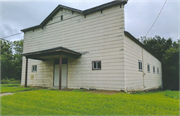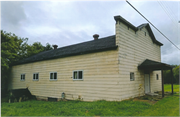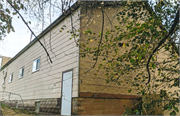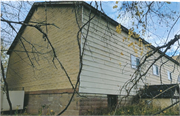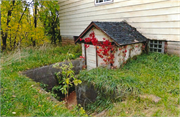Property Record
319 11TH AVE E
Architecture and History Inventory
| Historic Name: | ZCBJ Hall/Western Bohemian Fraternal Association Hall |
|---|---|
| Other Name: | BOHEMIAN HALL/WFLA HALL |
| Contributing: | |
| Reference Number: | 428 |
| Location (Address): | 319 11TH AVE E |
|---|---|
| County: | Ashland |
| City: | Ashland |
| Township/Village: | |
| Unincorporated Community: | |
| Town: | |
| Range: | |
| Direction: | |
| Section: | |
| Quarter Section: | |
| Quarter/Quarter Section: |
| Year Built: | 1912 |
|---|---|
| Additions: | |
| Survey Date: | 20102017 |
| Historic Use: | meeting hall |
| Architectural Style: | Boomtown |
| Structural System: | |
| Wall Material: | Asbestos |
| Architect: | |
| Other Buildings On Site: | |
| Demolished?: | No |
| Demolished Date: |
| National/State Register Listing Name: | Not listed |
|---|---|
| National Register Listing Date: | |
| State Register Listing Date: |
| Additional Information: | 1982: Vernacular boomtown false-front building with raised central gable interrupting flat cornice with Italianate brackets covered with pressed board. This building reportedly still retains its early painted stage cloth. 2010: Little in the way of alterations have been made to the building since last surveyed in 1982 (and again in 2000). The structure was built circa 1912 as a ZCBJ (Zapadni Ceska-Bratrska Jednota) Hall, which translates to Western Bohemian Fraternal Association. The building still functions as such, but the name has changed to the Western Fraternal Life Association. The exterior was remodeled to its current state in 1972, with the application of asbestos siding and downsized, slider windows. The small porch entry was added at an early date. Although the interior walls are now covered with paneling, the original pressed tin is believed to be intact beneath it. As well, despite the dropped ceiling, the original pressed tin ceiling is visible above. The original wooden floor remains intact and the original stage scenery/backdrop remains intact, as does the canvas drop cloth. which was painted by Emil Piller (like the CCBJ hall in the Village of Haugen, Barron County. 2017: No apparent exterior changes. 2017 survey information: Rising one story from a concrete block foundation, this gabled structure is sheathed with wide asbestos siding and features a Boomtown front with a central gable and a bracketed cornice. A hipped-roof, open porch entry fronts the primary entrance that consists of a pair of modern doors that rest beneath an original, multiple-light transom. Windows along the basement level are filled with glass block while the regularly placed, first-floor fenestration consists of two-light, slider examples. A historic photo of the building indicates that the siding was originally clapboard and windows were two-over-two-light examples. An oculus window was also previously located near the peak of the Boomtown front, below which was the (painted-on) name of the organization, “Western Bohemian Fraternal Association. Regarding the interior (which was inspected in 2010), the hall retains its original meeting space arrangement, including a central dance hall with wooden flooring, as well as a stage at the rear/westerly end. Although a ticket booth was historically located at the right of the front entrance area, it has since been converted into a bar area. The original coat storage space, located to the left of the entry, remains intact. Despite a dropped acoustical ceiling, the original pressed tin ceiling remains intact above it. And while the walls are covered with paneling, the original pressed tin walls are also believed to be intact behind it. The canvas stage drop cloth/curtain, as well as the stage backdrop, is original to the building and both were painted by Emil Piller, as evidenced by the signature on the drop cloth. Built circa 1912, this was the meeting hall of the ZCBJ (Zapadni Ceska-Bratrska Jednota), which translates to the Western Bohemian Fraternal Association (Ashland Lodge No. 126), a fraternal organization that continues to own, maintain and meet in the subject building. Organized in 1897, this group offered life insurance and acted as a support system for Czech immigrants and those of Czech descent. In 1947, lodge membership was opened to all ethnicities and, in 1971, the name was officially changed to Western Fraternal Life Association (WFLA). Identified at one time as “the jewel of the east side,” the structure boasted the best dance floor in town. Indeed, the structure has long been known for hosting a variety of polka bands, as well as rock bands in later years. In addition to being used for regular WFLA meetings, the building continues to be used for weddings, funerals and other social gatherings. In 1972, the existing siding was applied and the windows were replaced on the exterior, while paneling and a dropped ceiling were added on the interior. |
|---|---|
| Bibliographic References: | Architecture and History Survey. November 2010. Prepared by Heritage Research, Ltd. Information for the 2017 report (also by HRL) was based on the 2010 information cited above. |
| Wisconsin Architecture and History Inventory, State Historic Preservation Office, Wisconsin Historical Society, Madison, Wisconsin |

